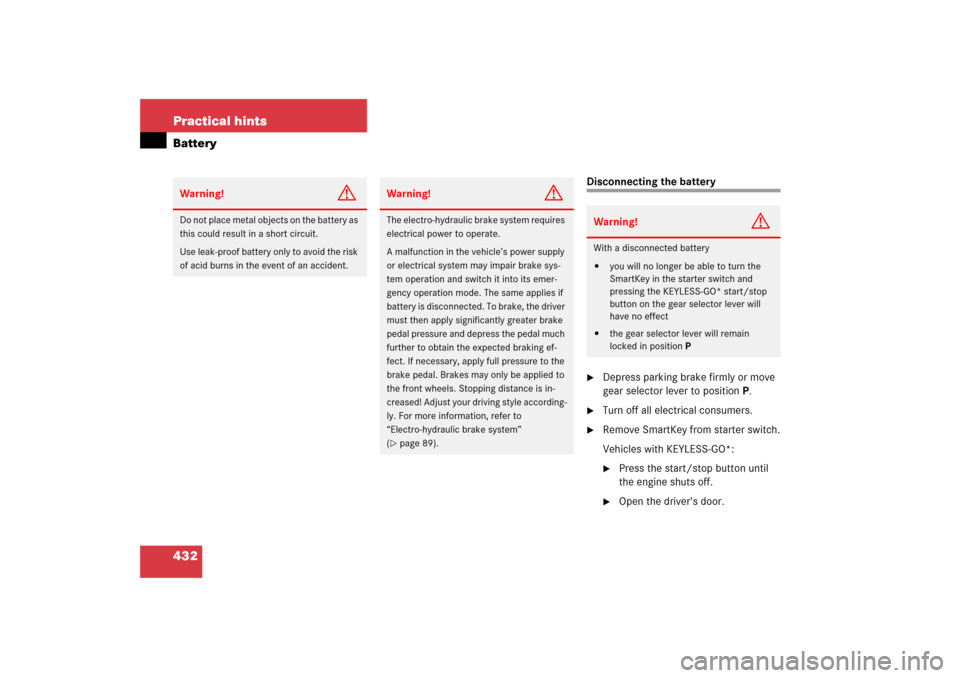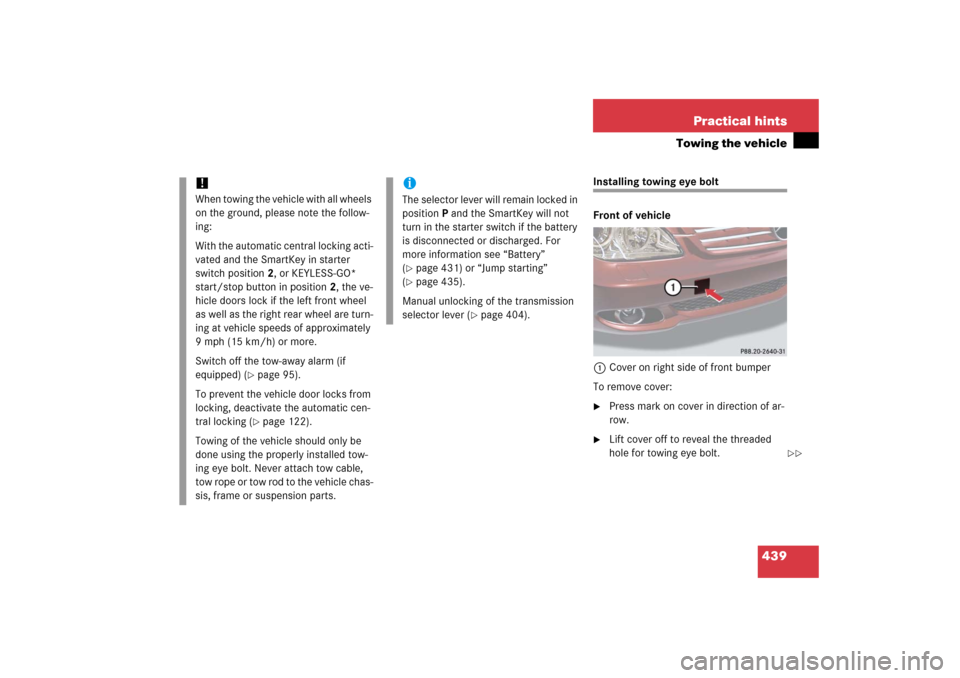Page 405 of 498
404 Practical hintsUnlocking/locking in an emergency1Locking�
Insert the mechanical key into the driv-
er’s door lock until it stops.
�
Turn the mechanical key clockwise to
position1.
The driver’s door is locked.
Fuel filler flap emergency release
In case the central locking system does
not release the fuel filler flap, you can open
it manually.
1Release knob�
Open trunk.
�
Remove right-side tail trim.
�
Pull release knob1 in the direction of
arrow.
The fuel filler flap can know be opened.Manually unlocking the gear selector
lever
In case of power failure, the gear selector
lever can be manually unlocked, e.g. to tow
the vehicle.
1Selector lever cover
2Release
��
Page 433 of 498

432 Practical hintsBattery
Disconnecting the battery�
Depress parking brake firmly or move
gear selector lever to positionP.
�
Turn off all electrical consumers.
�
Remove SmartKey from starter switch.
Vehicles with KEYLESS-GO*:�
Press the start/stop button until
the engine shuts off.
�
Open the driver’s door.
Warning!
G
Do not place metal objects on the battery as
this could result in a short circuit.
Use leak-proof battery only to avoid the risk
of acid burns in the event of an accident.
Warning!
G
The electro-hydraulic brake system requires
electrical power to operate.
A malfunction in the vehicle’s power supply
or electrical system may impair brake sys-
tem operation and switch it into its emer-
gency operation mode. The same applies if
battery is disconnected. To brake, the driver
must then apply significantly greater brake
pedal pressure and depress the pedal much
further to obtain the expected braking ef-
fect. If necessary, apply full pressure to the
brake pedal. Brakes may only be applied to
the front wheels. Stopping distance is in-
creased! Adjust your driving style according-
ly. For more information, refer to
“Electro-hydraulic brake system”
(�page 89).
Warning!
G
With a disconnected battery�
you will no longer be able to turn the
SmartKey in the starter switch and
pressing the KEYLESS-GO* start/stop
button on the gear selector lever will
have no effect
�
the gear selector lever will remain
locked in positionP
Page 440 of 498

439 Practical hints
Towing the vehicle
Installing towing eye bolt
Front of vehicle
1Cover on right side of front bumper
To remove cover:�
Press mark on cover in direction of ar-
row.
�
Lift cover off to reveal the threaded
hole for towing eye bolt.
!When towing the vehicle with all wheels
on the ground, please note the follow-
ing:
With the automatic central locking acti-
vated and the SmartKey in starter
switch position2, or KEYLESS-GO*
start/stop button in position2, the ve-
hicle doors lock if the left front wheel
as well as the right rear wheel are turn-
ing at vehicle speeds of approximately
9 mph (15 km/h) or more.
Switch off the tow-away alarm (if
equipped) (
�page 95).
To prevent the vehicle door locks from
locking, deactivate the automatic cen-
tral locking (�page 122).
Towing of the vehicle should only be
done using the properly installed tow-
ing eye bolt. Never attach tow cable,
tow rope or tow rod to the vehicle chas-
sis, frame or suspension parts.
iThe selector lever will remain locked in
positionP and the SmartKey will not
turn in the starter switch if the battery
is disconnected or discharged. For
more information see “Battery”
(�page 431) or “Jump starting”
(�page 435).
Manual unlocking of the transmission
selector lever (
�page 404).
��
Page 443 of 498
442 Practical hintsFusesMain fuse box in passenger compart-ment
1CoverOpening
�
Open the front passenger door.
�
Insert flat, blunt object as a lever in into
on the edge of cover1 at the position
indicated by the arrow.
�
Loosen cover1 from the dashboard
using lever.
�
Using your hands, pull cover1 in the
direction of the arrow and remove.
Closing
�
Hook cover1 into the opening at the
front.
�
Press cover1 back on until it engag-
es.
Fuse box in trunk
2Cover
3Catches�
Turn catches3 counter-clockwise
and remove cover2.
!Do not use sharp objects such as a
screw driver to open the fuse box
cover1 in the dashboard, as this
could damage it.
Page 473 of 498

472 Technical termsBar
(
�page 332)
BAS
(Brake A
ssist S
ystem)
System for potentially reducing braking
distances in emergency braking situa-
tions. The system is activated when it
senses an emergency based on how
fast the brake is applied.
Bead
(
�page 332)
Bi-Xenon headlamps*
Headlamps which use an electric arc as
a light source and produce a more in-
tense light than filament headlamps.
Bi-Xenon headlamps produce low
beam and high beam.CAC
(C
ustomer A
ssistance C
enter)
Mercedes-Benz customer service
center which can help you with any
questions about your vehicle and pro-
vide assistance in the event of a break-
down.
CAN system
(C
ontroller A
rea N
etwork)
Data bus network serving to control
vehicle functions such as door locking
or windshield wiping.
Cockpit
All instruments, switches, buttons and
indicator/warning lamps in the passen-
ger compartment needed for vehicle
operation and monitoring.Cold tire inflation pressure
(
�page 332)
Collapsible tire
An especially compact spare tire that
must be inflated with a provided air
pump before using. It should only be
used to bring the vehicle to the nearest
service station.
COMAND
(Cockpit M
anagement and D
ata
System)
Information and operating center for
vehicle sound and communications
systems, including the radio and navi-
gation system, as well as other optional
equipment (CD changer, telephone,
etc.).
Page 475 of 498

474 Technical termsFSS PLUS (Canada vehicles)
(F
lexible S
ervice S
ystem PLUS)
Maintenance service indicator in the
multifunction display that informs the
driver when the next vehicle mainte-
nance service is due. FSS evaluates
engine temperature, oil level, vehicle
speed, engine speed, distance driven
and the time elapsed since your last
service, calculates other maintenance
service work required, and calls for the
next maintenance service accordingly.
GAWR
(G
ross A
xle W
eight R
ating)
(
�page 332)
Gear range
Number of gears which are available to
the automatic transmission for shifting.
The automatic gear shifting process
can be adapted to specific operating
conditions using the selector lever.GPS
(G
lobal P
ositioning S
ystem)
Satellite-based system for relaying
geographic location information to and
from vehicles equipped with special
receivers. Employs DVD digital maps
for navigation.
GVW
(G
ross V
ehicle W
eight)
(
�page 332)
GVWR
(Gross V
ehicle W
eight R
ating)
(
�page 333)
Instrument cluster
The displays and indicator/warning
lamps in the driver’s field of vision, in-
cluding the tachometer, speedometer
and fuel gauge.KEYLESS-GO*
System for entering and operating the
vehicle without the use of a SmartKey.
Kickdown
Depressing the accelerator past the
point of resistance shifts the transmis-
sion down to the lowest possible gear.
This very quickly accelerates the vehi-
cle and should not be used for normal
acceleration needs.
Kilopascal (kPa)
(
�page 333)
Locking knob
Knob on the door which indicates
whether the door is locked or un-
locked. Pushing the locking knob down
on an individual door from inside will
lock that door.
Page 484 of 498

483 Index
Door
Entry lamps 143
Message in display 382
Remote door unlock (Tele Aid) 269
Door control panel 32
Door handle 32
Doors
Opening from inside vehicle 111
DOT 332, 473
Drinking and driving 279
Drive-dynamic seat* 127
Driving
Abroad 287
Hydroplaning 283
In winter 285
Instructions 46
Problems 56
Safety systems 84
Systems 222
Through standing water 287
Driving hints
Electro-hydraulic brake system 92
Driving instructions 279
Driving off 282Driving safety systems
ABS 84
BAS 86
Electro-hydraulic brake system 89
ESP
®
86, 473
Driving systems 222
Airmatic DC 238
Cruise control 222
Distronic* 226
Driving safety systems 84
Vehicle level control 239
DTR see Distronic*
Dual control
Airmatic DC 238
E
Easy-entry/exit feature* 42
Electric air pump 427
Electrical fuses see fuses
Electrical system, Technical data 458Electro-hydraulic brake system 89, 476
Activation 90
Deactivation 91
Driving hints 92
Messages in display 375, 376
Self-check 91
Warning lamp 89
Electronic Stability Program see ESP
®
Emergency calls
Tele Aid calls 263
Emergency operation
(Limp-Home Mode) 190
Emergency operations 406
Fuel filler flap 404
Gear selector lever, Unlocking 404
Locking/unlocking the vehicle 402
Power tilt/sliding sunroof,
manual operation 406
Remote door unlock 269
Trunk lid, Releasing trunk from
inside 120
Trunk lid, Unlocking 403
Emergency tensioning device see ETD
Page 486 of 498

485 Index
Front seats
Heating* 128
FSS (Canada vehicles) 339
FSS (Flexible Service System) 474
Fuel 291
Fuel reserve warning lamp 358
Premium unleaded gasoline 291
Fuel consumption statistics
After start 171
Since last reset 171
Fuel filler flap 290
Locking 290
Opening 290
Unlocking 290
Fuel requirements 466
Fuel tank
Filler flap 290
Fuels, coolants, lubricants etc. 461
Fuse box in trunk 442
Fuses 441
Fuse chart 441
Fuse extractor 441
Replacing 441
Spare fuses 441G
Garage door opener* 270
Gasoline see Fuel 291
GAWR 332
Gear range 474
Automatic transmission 181
Limiting 181
Shifting into optimal 183
Gear selector lever
Cleaning 349
Position 178
Global
Locking 101
Locking with KEYLESS-GO* 107
Unlocking 100
Unlocking with KEYLESS-GO* 107
Global Positioning System (GPS) 474
Glove box 251
Good visibility 191
GPS 474
Gross Axle Weight Rating see GAWR
Gross Vehicle Weight Rating see GVWR
Gross Vehicle Weight see GVW
GVW 332
GVWR 333H
Hands-free microphone 29
Hard plastic trim items, cleaning 349
Hazard warning flasher 140
Head restraint
Active head restraint 74, 124
Head restraints
resetting activated 407
Headlamps
Automatic headlamp mode 135
Bi-Xenon* 472
Cleaning lenses 346
Cleaning system* 191
Deactivating 59
Headliner, cleaning 350
Heated seats* 128
Height adjustment
Head restraints 41
Steering wheel 41
Vehicle level 239
High beam flasher 53, 138
High beam headlamps
Replacing bulbs 415
Switching on 53, 138
High mounted brake lamp 412